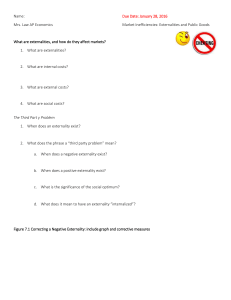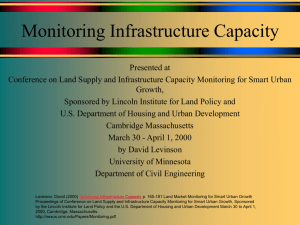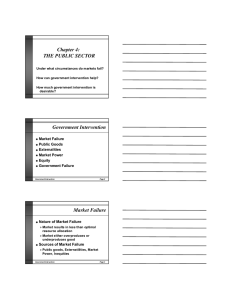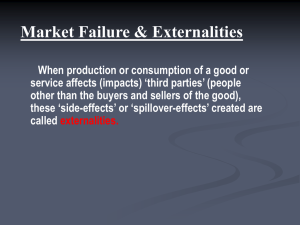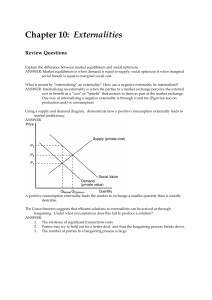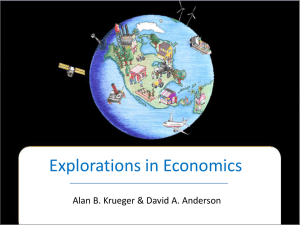11.433J / 15.021J Real Estate Economics MIT OpenCourseWare Fall 2008
advertisement
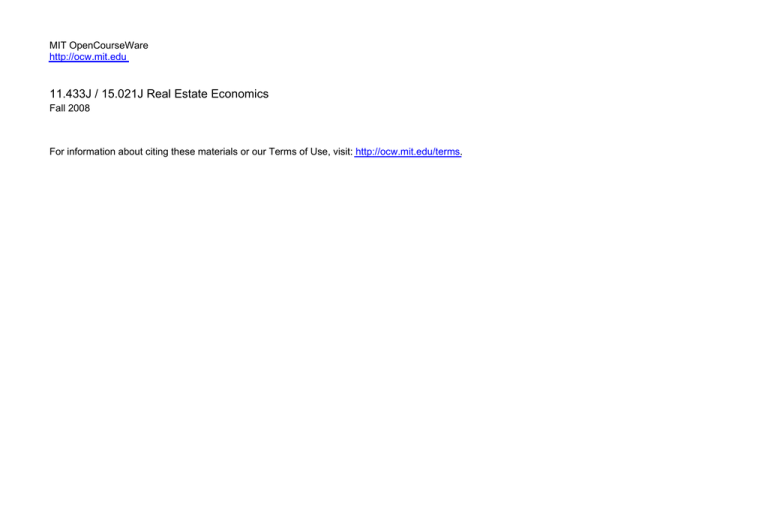
MIT OpenCourseWare http://ocw.mit.edu 11.433J / 15.021J Real Estate Economics Fall 2008 For information about citing these materials or our Terms of Use, visit: http://ocw.mit.edu/terms. Recitation 9 Real Estate Economics: Externality & Public Good Nov. 4, 2008 Jinhua Zhao Contents • Midterm Solution Review • Week 8 Class: Public good and externality • Hm4 hints Midterm exam • Scores: • Total score: • Mean: 72.1 • Std. Dev.: 12.2 • Score of each question • Mean Q1~Q4: 18, 22, 15, 17 • Std. Dev. Q1­Q4: 7, 3, 6, 4 • Solutions Contents • Midterm Solution Review • Week 8 Class: Public good and externality • Hm4 hints Externality and public good: outline • Introduction: example of open space – Free riding • Concept of public good and externality – Public good – Externality – Internalization: expand the market – Difficulties: Different evaluations/ Different benefits/Unknown information – Essence: 1 vs. 1/n – Classical economic explanation • Real Estate Examples (Instances of externality and public good) – Optimal density example revisited: Nash vs. cooperative solutions – Residential and industrial uses: history matters: locking current land use patterns – Regional open space and land constraint impacts – Traffic Congestion • How to remedy the externality problem – Coase Theorem: Private bargaining with contracts – One owner: large scale development – Government policies • regulation and taxation • Quantity based (quota) vs. Price based (tax, subsidy) Flavor of externality: example of open space: part I A number (n) of neighbors contemplate purchasing a vacant lot in their midst. • MV = valuation of the lot by each household • p = price of lot • MV >p/n , but MV<p Free riding with open space as a pure public good. Sharing? Exclusion? Voting? Flavor of externality: example of open space: part II Suppose park benefits depend on the number using it (n) MV(n) = valuation of the park by each (as a function of how many are sharing it) If the park is not excludable, how many will use it: MV(n0) = 0 so n0 = ∞ (possibly) [examples: Fishing, grazing] Total value of usage to group: nMV(n) How many should use to maximize total usage value: MV(n*) + n∂MV/∂n* = 0 MV(n*) = ­ n∂MV/∂n* >0, hence n* < n0 n0 ­ n* = degree of “over grazing, fishing…” If the park is excludable it can be “privatized”. Owner winds up setting an entrance fee as above = [­ n∂MV/∂n*]. Flavor of externality: example of open space: part III Two groups have different evaluations Group 1: n1, MV1(A) Group 2: n2, MV2(A) Total benefit: n1*MV1(A)+n2*MV2(A) Optimal A: (n1/n) * MV1(A*) + (n2/n) MV2 (A*) = p/n Majority voting system: the group with more people always win: tyranny of the majority System optimal: not preferred by any group Possible solution: separate the two groups Concept of public good and externality • Public good – Features: • • • • • Non­excludable; • non­exhaustible – Public vs. private goods • Private good: adding demand horizontally • public good: adding demand vertically Externality: one agent impacts other agents but NOT reflected in price Internalization: expand the market • Difficulties: − Different evaluations − Different benefits − Unknown information Essence: 1 vs. 1/n Classical economic explanation Ex.1: Optimal density example revisited Nash vs. cooperative solutions Individually: only consider the external cost imposed by other property owners Collectively: also consider his external impact upon others P = α ­ βF ­ γf F = FAR of subject’s lot f = FAR of neighbors β = marginal impact of own FAR on price γ = marginal impact of neighbor FAR α = all other location factors C = µ + τF Ex.1: Optimal density example revisited Individually: p = [(α­µ) – (τ + β)F ­ γf]F Collectively: p = [(α­µ) – (τ + β)F ­ γF]F Individually optimal solutions: Fm = (α­µ) / [2(τ + β) + γ] pm = (α­µ)2 (τ + β) /[2(τ + β) + γ]2 Collectively optimal solutions: F* = (α­µ) / 2(τ + β + γ) , F* < Fm p* = (α­µ)2 / 4(τ + β + γ) , p* > pm Ex. 2: Land use pattern and externalities: history matters! Industrial use rent: rI(d) = rI ­ kId Residential use rent: rH(d) = rH ­ kHd + |m­d| γ kI,kH = marginal values for commuting γ = marginal valuation of distance from industries by households Now there are two factors that determine rents: commuting and proximity to industry. Ex. 2: Land use pattern and externalities: history matters! Multiple equilibriums exist. Land Rent History matters! rl - kld rH - kHd + [d - m] γ Which patterns maximizes regional land value? Industries Households m No one wants to move first. ra b distance (d) Land Rent rH - kHd + [m - d] γ rl - kld Households Industries m ra b distance (d) Alternative locational equilibria with residential and industrial uses Figure by MIT OpenCourseWare. Ex. 3: Regional open space and land constraint impacts Impacts of regional open space policy: Always raises house prices and land values. How much is from constricting supply as opposed to generating true “public good” benefits? London Green Belt, Seattle growth boundary Land rent b’ : post restriction b : pre restriction b’ b green belt Ex. 3: Regional open space and land constraint impacts California Coastal Commission Zoning House Rent Public Good Effect Restriction Ocean : “pre” land rents : “post” land rents Supply Restriction Effect Desert Additional examples of public goods/externalities Infrastructure: sidewalks, roads, waterways, lagoons..in addition to open space. Historic Districts. 1. Designation provides insurance and control against adverse design/use (a public good). 2. Downside is loss of individual development options. 3. Empirical issue: suppose “better” properties are chosen for historic designation? Comprehensive Development Design. Is the “style” of your property an externality to others? Yes in Europe, no in the US. Examples of “externalities” in commercial Real Estate: 1. Office Building height: views versus view blockage, the market for air rights. 2. “Good” office architecture. Where is the externality, tenants or neighbors? 3. Adjacent retail stores: shopping centers How to remedy externalities Solutions to Public Good/Externality Problems. • Larger scale development • Government policy, public regulation, planning • Private bargaining with contracts: Coase Theorem How to remedy externalities: large scale development Scale: Single (collective) ownership of a large parcel of land insures few negative and many positive externalities at development stage Single owner maximizes the total value of development – sacrificing value at one location if such a sacrifice creates more value at other locations. Is the “whole” always worth more than the sum of the parts? [Liquidity – versus – externalities]. Does the price of an acre decrease/increase with the size of purchase With large scale Private development, what happens later on – maintaining the original concept and adapting to change. Are covenants and restrictions enough? Lessons from Houston, Hilton Head How to remedy externalities: public regulation and planning Public Regulation/Planning. Careful public regulations and master­planning could achieve such harmony and maximize aggregate land value If you trust planners or politicians • Information? • Incentive? How to insure this – give them a stake? “Town Architects” in Europe. What if there is little consensus on what good design is? How to remedy externalities: private bargaining: Coase Theorem Ronald Coase The economic efficiency of an economic allocation or outcome in the presence of externalities. Condition: 1. Trade is possible 2. No transaction costs 3. Property rights well defined Outcome: 1. Efficiency: the prevailing outcome will be efficient 2. Invariance: the ultimate outcome will be the same regardless of the initial allocation of property rights. The party engaging in the more valuable conflicting activity will buy the legal right from the other party engaged in conflicting activity. In practice: obstacles to bargaining or poorly defined property rights can prevent Coasian bargaining. Criticism: transaction costs are almost always too high for efficient bargaining to happen. The bargaining doesn't happen between two economic factors, but instead the parties might be a single large factory versus a thousand landowners nearby. Transportation Congestion • Vickrey 1963: – No other major areas are pricing practices so irrational, so out of date, and so conducive to waste as in urban transportation • Travel demand congestion Sort travelers according to their valuation of car usage: W(V) V is the # travelers who value using their car by at least W dollars per trip W(1) is the value of the highest valuer in the population If travel costs C0, then V0 is the solution to W(V0)=C0 V0 people drive, and the total value of all auto usage is: V0 ∑W(V) >C0V0 V=1 • Traffic congestion: Equilibrium. As more travelers use their cars, the cost of travel for each rises: C(V), ∂C/∂V>0. Ask what travel usage V0 equalizes the value of usage to the last user with the cost of that trip: W(V0) = C(V0) Still true that total value [∑W(V)] > C(V0)V0 Can we do better? Transportation Congestion Optimal traffic level Ask what travel usage V* maximizes the aggregate value of usage­minus­total­costs: V* ∑ W(V) – C(V*)V* V=1 Answer: W(V*) = C(V*) + V* ∂C/ ∂V and V* < V0 How to implement a). Let the V* car users pay the V0 ­ V* (lower valuing) people not to drive! The gain to the V* users is greater than the payment, and the value of the payment to the receivers is greater than their loss of driving. b). Enact a toll or charge for driving of: V* ∂C/ ∂V (social cost). General observations Travel distortions – Policy implications ­ People drive too often ­ Trips are too long (uses too spread out) ­ Transit and other less congestion­prone modes are not used enough ­ Peak periods of travel need to be broadened: work hours need to be spread out. ­ When development creates traffic it needs to be taxed/regulated (!) ­ Not only for local infrastructure, but for regional traffic impacts as well. ­ Impacts beyond local jurisdiction borders bargaining between town­ Developer is not enough Contents • Midterm Solution Review • Week 8 Class: Public good and externality • Hm4 hints Hm4 hints 1. Total Cost = Money Cost + Time Cost 2. time per mile = .05 (volume/1,200,000)2 3. Total Cost = Money Cost + Time Cost 4. Equilibrium condition: a commuter is indifferent between going to work by car or by rapid transit: Total Cost by Car = Total Cost by Metro 5. System optimal condition: typical optimization problem: minimize total travel cost by choosing the best # of transit commuters 6. Comparison between User Equilibrium with System Optimization 7. How to implement the system optimal solution: – One possibility is to charge road toll, but how to calculate the toll? – Hint: charge a toll to car users so that the two groups have the same total travel costs at the System Optimal condition. 8. Discount rate

